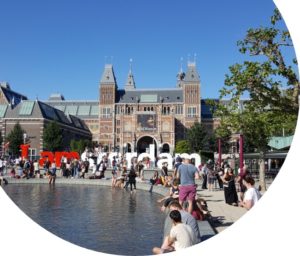
Written by the 2nd year students, MPhil Textile Conservation, compiled and edited by Emma Smith.
For the last course of the first year of the MPhil Textile Conservation, we undertake a six week minimum work placement, giving us an opportunity to put the skills we have learnt in the first year into practice in a real world conservation studio. This year the placement institutions we chose were largely UK based, with placements undertaken at The British Library, The British Museum, National Museums Scotland, People’s History Museum, and Victoria and Albert Museum, as well as further afield at the Rijksmuseum in Amsterdam and The Textile Museum in Washington DC. In this two part blog, you can follow some short excerpts of our experiences over the summer placements. Part 1 covers Placements around and about, whilst Part 2 concentrates on those in central London.
Eva (Rijksmuseum and The Textile Museum )

Early on in the first year, when Karen Thompson, our placement convenor, offered us museums for placements, I instantly knew that I wanted to go abroad and gain as much international experience as possible. In the end I decided to have two placements in two different countries – one ‘official’ placement at the Rijksmuseum in Amsterdam, and the other one at The Textile Museum in Washington DC. During my 16-weeks in total, I was able to conduct interventive treatments on museum objects both flat and 3D, help with costume mounting and preparing mannequins for a chintz-exhibition, work with European and East Asian textiles, tapestries and Turkish carpets and help with installation and de-installation of objects from various material groups.
The most interesting part was the people I met and the discussions I had about their experiences in the field of textile conservation. Both studios at the Rijksmuseum and The Textile Museum have, besides their mission to care for their collection, an aim in public engagement and research. In addition to my experiences in interventive conservation I was therefore able to help organise various workshops and conferences. One of the highlights was definitely the ICOM-Costume Annual Meeting in the Netherlands, for which I volunteered during the whole week and gained an insight into the effort required to plan such an event. Another highlight was the opportunity to go to Washington DC and experience conservation in a North-American museum. I particularly enjoyed the very interesting methods of mount-making I learned in the USA and my visit to the conservation studios at the National Museum of the American Indian (NMAI), which showed me how diverse the world of textile conservation actually is.
Chuance (People’s History Museum )
My placement at People’s History Museum in Manchester was for 8 weeks. I worked in the Textile Conservation Studio under the supervision of Senior Textile Conservator, Jenny van Enckevort. Apart from the interventive and preventive conservation project works, I also had the opportunity to attend acquisition meetings where I gained insights into wider museology practice. One of the highlights of my placement was being involved with object viewing, where I got to experience handling large historical banners and appreciate them up close! If you are visiting Manchester, do make a visit to PHM and remember to catch the conservators in action at the textile conservation viewing area!

Andrea (National Museums Scotland and Victoria and Albert Museum )
My summer placement started at the National Museums Scotland in Edinburgh with the Textile and Paper Conservation department. During my six weeks there, I inserted patches into 18thC. Chinese trousers, wet cleaned a sampler, mounted costumes, helped Preventive Conservation package horse collars at the National Museum of Rural Life, undertook dye analysis with the analytic scientist, helped install a new major exhibition, and much more. After a week of working on our summer writing assignment, I began a second four week placement at the Victoria and Albert Museum in London, focussing mainly on mounting. I mounted several Korean men’s hat, a task which included constructing a male mannequin with Fosshape™ and papier-mâché from the collarbone up, to match a female one already available. I also mounted a Korean woman’s headdress, which required me to make hair out of paper that would interpret and support the heavy object. All of the projects that I worked on this summer were challenging and tested the skills that I had gained during the first year at the CTC. The teams at both museums were lovely to work with, and I appreciate all that they shared with me!
Kayla (Knole Conservation Studio)
My placement was at the Knole Conservation Studio, at the National Trust property Knole House in Kent under the supervision of Heather Porter, Senior Conservator (Upholstery). The placement gave me an opportunity to learn about upholstery conservation, a specialty within conservation in which I would like to specialize in the future. Throughout the placement I was introduced to different textile and upholstery conservation techniques practiced by my supervisor and contract conservators and I undertook the conservation of several upholstered stools from Knole’s large collection of Stuart furniture. Knole Conservation Studio is an open-to-the-public studio; therefore I was able to engage with visitors by demonstrating conservation techniques and speaking to incoming tours about ongoing treatments in the studio. In addition to working in the studio, I assisted the housekeeping team on two occasions with cleaning of the showrooms. This gave me a glimpse into how preventive conservation is practiced in a historic house. My placement at Knole has given me experience in upholstery conservation and furthered my practical knowledge of preventive conservation, which will be instrumental as I continue to develop as a professional in the second year of the program at the CTC.



Absolutely fascinating, thanks to all for a most interesting and exciting read about the placements. Best wishes, Simon and Dawn